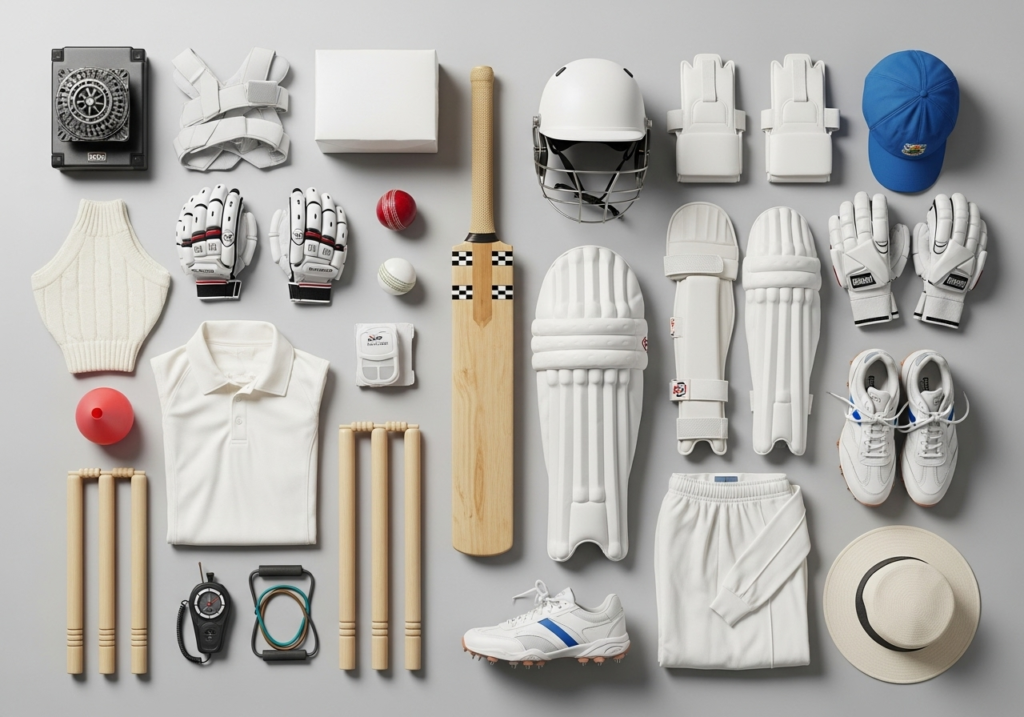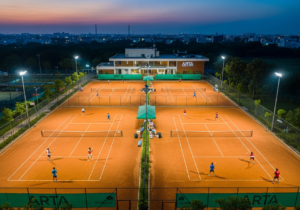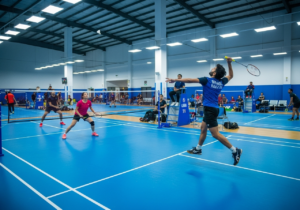Equipment Used in Cricket: A Complete Checklist

Cricket is one of the most equipment-driven sports in the world. Every piece of gear, from bat to helmet, is designed with a purpose– enhancing performance while ensuring player safety. For anyone serious about understanding the game, knowing the complete list of equipment used in cricket is essential.
In this comprehensive article, you’ll find every major item categorised for easy reference. The focus is not only on what players use but also why these items are vital on the field.
List of Equipment Used in Cricket: At a Glance
| Equipment | Purpose |
| Bat | Primary tool for batting and scoring runs. |
| Ball | Used by bowlers to dismiss batters and restrict runs. |
| Helmet | Protects the head and face against fast deliveries. |
| Batting Pads | Shields shins and knees from impact. |
| Gloves | Grip and protection from ball impact. |
| Abdominal Guard | Protects sensitive areas. |
| Thigh, Arm, Chest Guards | Safety against short-pitched deliveries. |
| Shoes with Spikes | Traction and stability on turf pitches. |
| Clothing | Comfort and tradition; varies by match format. |
| Wicketkeeping Gear | Support catching and movement behind stumps. |
| Stumps and Bails | To form the wickets. |
| Training Gear | Used for practice and skill development. |
| Umpire Equipment | Ensures match management and oversight. |
Cricket Bat
The bat is the most recognisable piece of equipment used in cricket. Crafted from willow wood, it features a flat striking surface and a conical handle bound with grip material. According to the Laws of Cricket, bats cannot exceed 96.5 centimetres in length or 10.8 centimetres in width.
Most bats weigh between 1.2 kilograms and 1.4 kilograms, allowing players to balance power and control. Professionals select their bats based on playing style. Power hitters lean toward heavier blades, while stroke players prefer lighter models for quicker manoeuvrability.
Indeed, choosing a good bat is mandatory to improve batting skills for competitive matches.
Cricket Ball
The ball used in cricket is a cork core layered with tightly wound string and finished with a leather cover. Its hardness and weight lie between 155.9 grams and 163 grams, which makes protective equipment indispensable.
Colours vary by format:
- Red balls dominate in Test and First-Class matches.
- White balls are standard in One-Day and T20 games.
- Pink balls are used in day-night Tests for better visibility under lights.
Understanding the ball’s condition is central to strategy, as seam position and shine impact swing and spin.
Protective Gear and Safety
Safety is a priority in cricket due to the high-speed impact of the ball. The list of equipment used in cricket for protection includes:
Helmet: Constructed with a hard outer shell, face grill, and padded lining. Helmets protect against head injuries, especially when facing fast bowlers.
Batting Pads: Worn on both legs, these shield knees and shins from the ball. They are secured with straps and extend from the ankle to above the knee.
Gloves: Batting gloves are padded across the fingers and palm, enhancing grip while cushioning against impact. Wicketkeepers wear specialised gloves with webbing between the thumb and index finger to aid in catching.
Abdominal Guard (Box): A small but critical item that safeguards sensitive areas.
Thigh Guards, Arm Guards, and Chest Guards: Additional layers of protection chosen by players based on comfort and role.
Without this protective gear, cricket would be an unsafe sport to play at competitive levels.
Clothing and Footwear
Cricket clothing has evolved, blending tradition with function.
Shirts and Trousers: Traditionally white for Test matches; coloured kits are used in limited-overs formats. Modern fabrics are lightweight, breathable, and moisture-wicking.
Shoes: Cricket shoes are specialised with spikes on the sole to provide traction on turf pitches. Bowlers wear reinforced shoes for ankle and heel stability, while batters favour lighter models for agility.
Sweaters and Caps: Sweaters keep players warm during early morning or evening matches. Caps and sunhats provide comfort and protection from the sun.
Fielding Equipment
While most fielders use minimal gear, wicketkeepers require specialised equipment.
Wicketkeeping Pads: Lighter and shorter than batting pads, designed for quick movements behind the stumps.
Wicketkeeping Gloves: Distinctly different from batting gloves, with a larger catching surface.
Close-in fielders may also use shin guards under trousers for extra protection against fast-reacting shots.
Cricket Stumps and Bails
The stumps are three vertical wooden posts, each 71.1 centimetres tall, embedded into the ground. Two small pieces of wood called bails rest on top. Together, they form the wicket.
The primary objective of the bowler is to hit the stumps or dislodge the bails, while the batter’s responsibility is to defend them.
Training and Practice Equipment
Apart from the gear used in matches, training requires specialised equipment.
Practice Nets: Enclosed nets where bowlers and batters hone their skills.
Bowling Machines: Devices that simulate deliveries at various speeds and angles.
Cones and Markers: Used for fielding drills, cricket fitness routines, and exercises that build endurance over long sessions.
Resistance Bands and Training Aids: Support strength and conditioning exercises specific to cricket.
These additions ensure players maintain form and fitness throughout the season.
Umpire Equipment
Counters/Clickers: To keep track of balls in an over.
Protective Hat or Cap: Guards against sun exposure.
White Coat or Shirt: A long-standing tradition for visibility on the field.
Although less discussed, umpire equipment contributes to the smooth conduct of matches.
Final Thoughts
Understanding the complete range of equipment used in cricket deepens appreciation for the sport. Every item serves a purpose. Some protect, others enhance performance, while a few uphold the traditions of the game.
For players at any level, familiarity with all equipment used in cricket is the first step toward improving both skill and safety. For fans, it adds depth to watching the game, providing context for why cricketers wear and use what they do.
FAQs
What is the difference between Test and limited-overs cricket equipment?
Test cricket uses red balls and white clothing, while limited-overs formats use white balls and colored kits. Protective gear and bats remain the same across formats.
How do I choose the right size cricket bat?
Choose a bat according to your height and playing style. You can choose from Junior, youth, and senior sizes. It ensures balance, comfort, and proper stroke control.
Do professional players use custom-made gear?
Yes, professionals frequently use custom-fitted bats, gloves, and pads. They’re designed for their body size and style, ensuring comfort, safety, and maximum performance on the field.
Can cricket equipment be used for training at home?
Yes, compact practice nets, tennis balls, and lightweight bats allow effective home training. You can improve batting skills and reflexes without needing a full ground.




